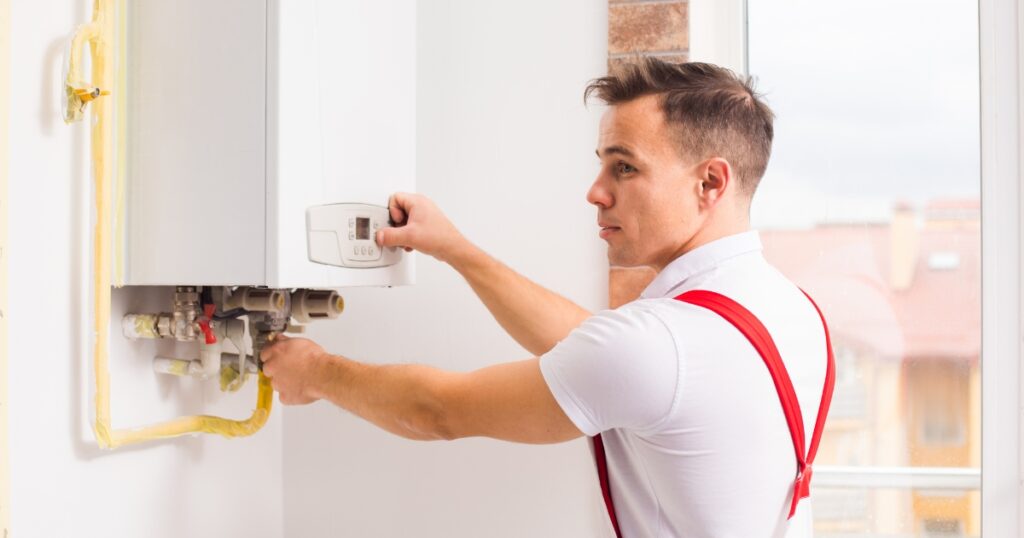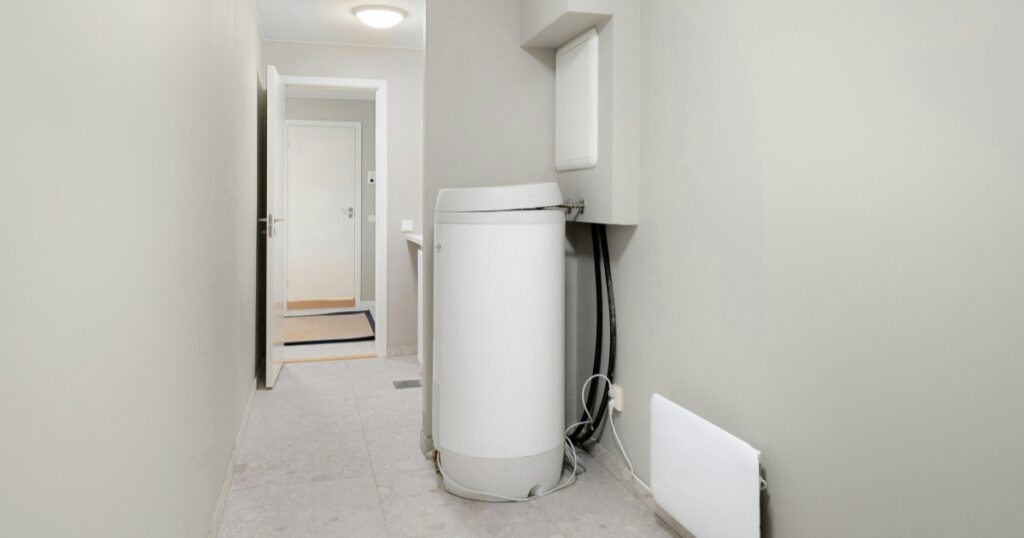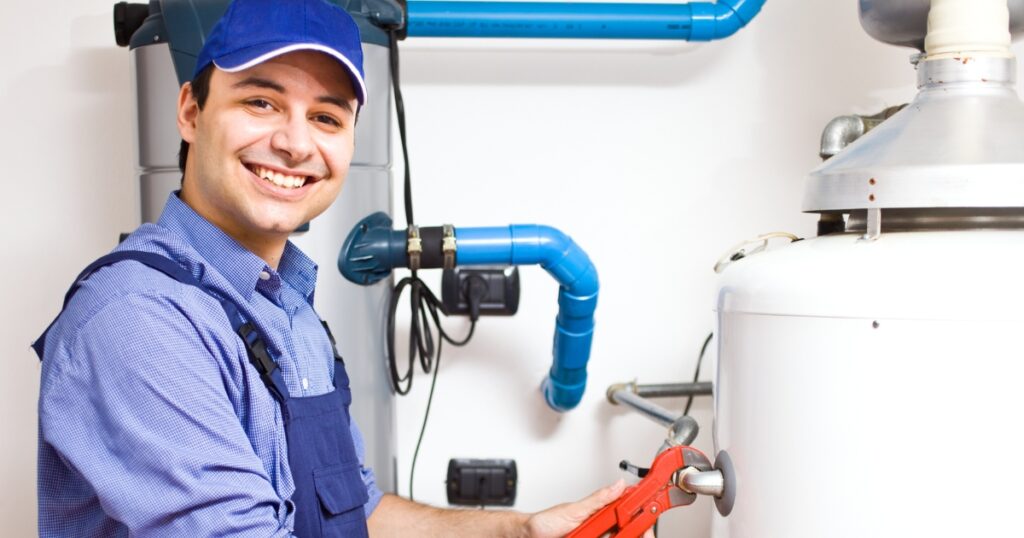Ahh, that moment when a chilly blast from the shower jolts you awake — and not in a good way. Seems like we’ve all been caught out by this at one stage or another. The surprise of cold water when you’re geared up for a toasty warm one can be a real downer.
But fear not! I’ve dug deep into the nitty-gritty of hot water system troubles so you don’t have to shiver through them any longer. This yarn’s about giving you the know-how and some handy hints to tackle those pesky problems head-on.
So stick around for some ripper DIY fixes that’ll get your hot water running as smoothly as a dream – because no one deserves an unexpected cold shower surprise!
Key Takeaways
- Regular maintenance such as flushing the tank annually can prevent sediment buildup and prolong the lifespan of your hot water heater.
- Promptly addressing signs of failure, such as inconsistent heating or leaks, can help avoid costly repairs and ensure uninterrupted access to warm water in your home.
- Understanding how to shut off the power/gas supply, drain the tank, and employ safety precautions when attempting DIY repairs is crucial for minimising potential hazards and ensuring safe troubleshooting.
Causes of Hot Water System Failure
Sediment buildup can lead to reduced heating efficiency and clog the tank, causing overheating and system failure.
Sediment buildup
Sediment buildup in your hot water system can be a real troublemaker.

Over time, minerals like calcium and magnesium commonly found in your water supply accumulate at the bottom of the tank.
This layer of sediment acts like an unwanted blanket, making it harder for your heater to warm up the water efficiently.
To keep our hot water systems running smoothly, we need to flush out this gunk periodically. Draining the tank once a year is a good habit that helps prevent sediment from affecting performance and lifespan.
If neglected, not only will you face longer waits for hot showers, but energy bills might also surge as the system strains to heat through the buildup. Let’s avoid letting sediment turn our essential comfort into a costly headache!
Faulty heating element
If your hot water system is not producing enough hot water or the water is not getting hot at all, a faulty heating element could be the culprit. This issue can be caused by sediment buildup on the heating element, which reduces its efficiency in heating the water.
It’s crucial to regularly inspect and clean the heating element to prevent this issue. In addition, ensuring that the thermostat settings are correctly adjusted can help avoid potential problems with the heating element.
Understanding how to troubleshoot and address a faulty heating element can save you from unnecessary repair costs and inconvenience. Regular maintenance and keeping an eye on warning signs are key to preventing issues with your hot water heater.
By recognising these signs early, homeowners can take proactive steps to ensure their hot water system continues to function efficiently for years to come.
Thermostat failure
Checking the thermostat settings is crucial when dealing with a hot water system repair. Homeowners need to ensure that the thermostat is set at an appropriate temperature to avoid issues with their water heater.
It’s also important to consider whether the thermostat itself needs replacing, as a faulty thermostat can lead to inconsistent heating and potential energy wastage.
Understanding the importance of checking and adjusting the thermostat setting on your hot water system is essential for maintaining efficient performance. Regular monitoring of the thermostat can prevent potential overheating or insufficient heating of water.
Corrosion in tank
If left unaddressed, thermostat failure can lead to another common hot water system issue: corrosion in the tank. Corrosion occurs when the metal of the tank deteriorates due to exposure to water and other elements over time.
It can result in leaks, reduced heating efficiency, and ultimately system failure. Regular maintenance and inspection are crucial for identifying corrosion early and taking steps to mitigate it.
Hot water heater tanks should be regularly checked for signs of corrosion, such as rust or weakened areas. If detected early, repairs or protective measures like sacrificial anode rod replacement can help prevent further damage.
Gas supply problems
If left unresolved, gas supply problems can severely impact the functionality of your hot water system. Checking for issues with the gas supply is crucial to ensuring that your water heater operates efficiently and consistently.
It’s important to pay close attention to any signs of gas leaks, such as a rotten egg odour or hissing sounds near the gas line. If you suspect a potential problem with the gas supply, it’s imperative to turn off the gas flow immediately and seek professional assistance.
Ignoring gas supply problems can pose serious safety risks and result in further damage to your hot water system.
Electrical issues
Electrical issues with hot water systems can often lead to problems such as no hot water or inconsistent heating. It’s essential for homeowners to be aware of potential electrical issues, which may include faulty wiring, a malfunctioning heating element, or a tripped circuit breaker.
Regularly checking the electrical components and connections can help ensure that the system operates efficiently and safely. If left unchecked, these issues could result in increased energy consumption and potentially lead to complete system failure over time.
Understanding how to troubleshoot common electrical problems can help homeowners address issues promptly before they escalate further. When dealing with any electrical aspects of the hot water system, it is crucial to exercise caution and consider seeking professional assistance if necessary.
By maintaining an awareness of potential electrical concerns, homeowners can take proactive steps to preserve their hot water system’s functionality and performance.
What to Do When Your Hot Water System Fails
Shut off the power/gas supply
To ensure safety, it’s crucial to shut off the power or gas supply to the hot water system immediately if you suspect a failure. By cutting off the power source, you can prevent any further damage and reduce the risk of accidents.
This step is essential before attempting any maintenance or repair work on your hot water heater.
Once we have shut off the power/gas supply to the unit, we can proceed with confidence that we are minimising potential hazards and preparing for safe troubleshooting or professional intervention.
Shut off the water supply
To shut off the water supply to your hot water system, locate the main shutoff valve connected to the system. Turn the valve clockwise until it is fully closed. This will stop the flow of water into your hot water heater and prevent any further damage in case of a leak or malfunction.
Remember to exercise caution when operating the valve and always ensure that it is completely closed before proceeding with any repairs or maintenance.
After shutting off the water supply, you can proceed with draining the tank and troubleshooting for issues causing the failure of your hot water system. Taking these initial steps can help homeowners minimise potential damage and safety risks associated with a malfunctioning hot water heater.
Drain tank
After shutting off the water supply, draining the tank is a crucial step in hot water system maintenance. This process helps remove built-up sediment and mineral deposits that can hinder the efficiency of your water heater.
To drain the tank, attach a garden hose to the drain valve at the base of the tank and run it to a suitable drainage area. Open the valve and let the water flow until it runs clear, indicating that most of the sediment has been removed.
Regularly draining your hot water tank can prolong its lifespan and ensure optimal performance, ultimately saving you money on repairs or replacements.
Troubleshoot or call a professional
To troubleshoot a failing hot water system, start by checking the thermostat settings to ensure they are at the correct temperature. Next, inspect for any leaks and corrosion in the tank and connections.
If you have a gas hot water system, verify that there are no issues with the gas supply. For electric water heaters, confirm that there are no electrical problems affecting their performance.
If you encounter any complex issues or are uncomfortable performing troubleshooting tasks, it’s best to call a professional plumber to accurately diagnose and repair your hot water system.
Safety precautions for DIY repairs
Before attempting any DIY repairs on your hot water system, it’s crucial to prioritise safety precautions. Start by turning off the power or gas supply to the water heater and shutting off the water supply.
Drain the tank completely before beginning any repair work. Always wear protective gear such as gloves and eye protection to prevent potential injuries from hot water or chemicals.
Be sure to thoroughly read and understand the manufacturer’s instructions for your specific water heater model before starting any DIY maintenance or repairs.
Regularly inspecting your hot water system for signs of wear and tear can help catch issues early, reducing the likelihood of sudden failures that could lead to dangerous situations.

Preventative Maintenance for Hot Water Systems
Regular maintenance is essential for keeping your hot water system in good working condition, so make sure to clean the tank, examine the anode rod, and repair any parts before they fail.
Cleaning tank
To maintain an efficient hot water system, cleaning the tank is essential. Over time, sediment can build up at the bottom of the tank, affecting its performance and reducing its lifespan.
Flushing the tank regularly removes this sediment and helps prevent clogging and corrosion. Additionally, inspecting and replacing the anode rod when necessary is crucial for protecting the tank from rust and extending its longevity.
Regular maintenance like cleaning the tank ensures that your hot water system continues to function efficiently. By following these simple steps, you can avoid potential issues with your hot water heater in Australia.
Examining anode rod
After cleaning the tank of your hot water system, it’s important to move on to examining the anode rod. This component plays a crucial role in preventing corrosion within the system by attracting corrosive elements in the water.
As homeowners, it’s vital to inspect and replace the anode rod regularly as part of preventative maintenance. By doing so, you can extend the lifespan of your hot water heater and avoid potentially costly repairs or replacements.
Additionally, keeping an eye on this key element ensures that your hot water system continues to function efficiently.
Repairing parts before failure
Regularly maintaining and inspecting your hot water system can help you identify any parts that may need repair before a complete failure occurs. By examining the anode rod and other components, homeowners can catch potential issues early on.
This proactive approach can save time and money in the long run by preventing major malfunctions and prolonging the life of the water heater. Monitoring and repairing parts before they fail ensures that your hot water system continues to operate efficiently, minimising disruptions to your daily routine.
Best Practices for Maintaining Hot Water Systems
- Regularly flushing the tank to remove sediment buildup and prevent corrosion.
- Inspecting and replacing the anode rod to extend the life of your hot water system.
- Checking for leaks and corrosion to address issues before they become major problems.
Flushing the tank regularly
To maintain a hot water system, homeowners should flush the tank regularly to remove sediment buildup. Neglecting this simple task can lead to decreased efficiency and even system failure.
Flushing the tank helps to prevent sediment from forming at the bottom of the tank, which can cause corrosion and reduce heating efficiency over time.
By flushing the tank on a regular basis, homeowners can ensure that their hot water system continues to provide reliable and efficient performance. This preventative maintenance step is easy to overlook but can significantly extend the lifespan of a water heater while also improving its overall performance and energy efficiency.
Inspecting and replacing anode rod
Inspecting and replacing the anode rod is a vital part of hot water system maintenance. The anode rod helps prevent corrosion inside the tank by attracting minerals that would otherwise corrode the tank walls.
To check the condition of the anode rod, turn off the power supply and water to your heater, then locate and remove the anode rod from its access port on top of the unit. If it’s less than ½ inch thick or coated in calcium deposits, it needs replacing.
To replace the anode rod, first empty some water from your tank using a hose connected to the drain valve. Then unscrew and remove the old anode rod with a socket wrench and insert a new one following manufacturer guidelines.
Checking for leaks and corrosion
After inspecting and replacing the anode rod, it’s important to regularly check for leaks and corrosion in your hot water system. Start by examining all visible pipes, fittings, and connections for any signs of water leakage.
Take note of any rust or discolouration on the tank or its components as they may indicate corrosion. Be sure to address any leaks immediately to prevent further damage and maintain the efficiency of your hot water system.
Regularly checking for leaks and corrosion is crucial in preventing unexpected failures and extending the lifespan of your hot water heater. Additionally, addressing these issues promptly can save you money on costly repairs down the line.
Learn More about Hot Water Heater Repair
In conclusion, maintaining a hot water system is crucial for homeowners. Regular maintenance and prompt repairs can prevent costly issues in the future. Understanding the signs of failure and taking necessary precautions are vital in ensuring the longevity of your hot water heater.
By following this comprehensive guide, homeowners can effectively troubleshoot and maintain their hot water systems, ensuring uninterrupted access to warm water in their homes.






